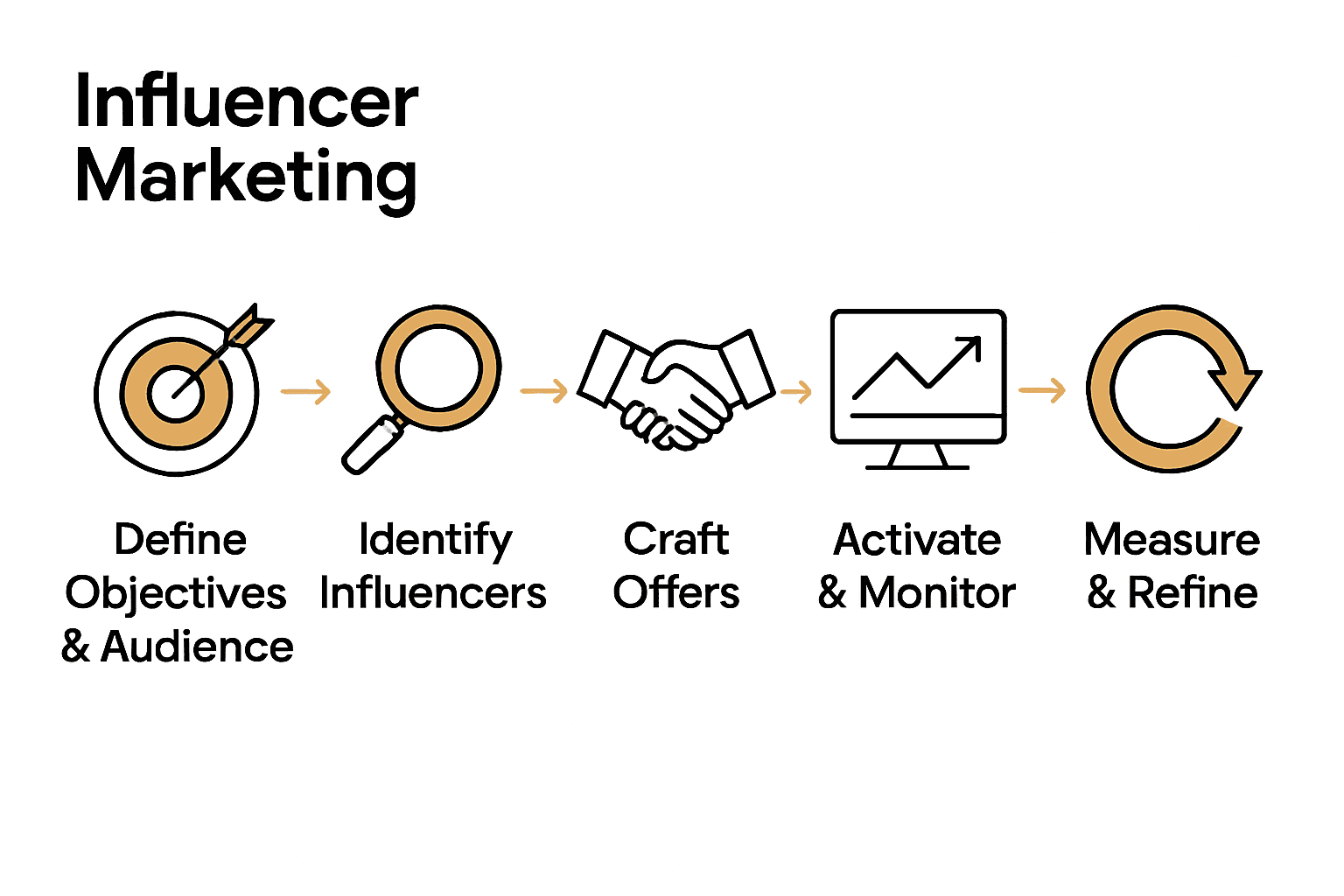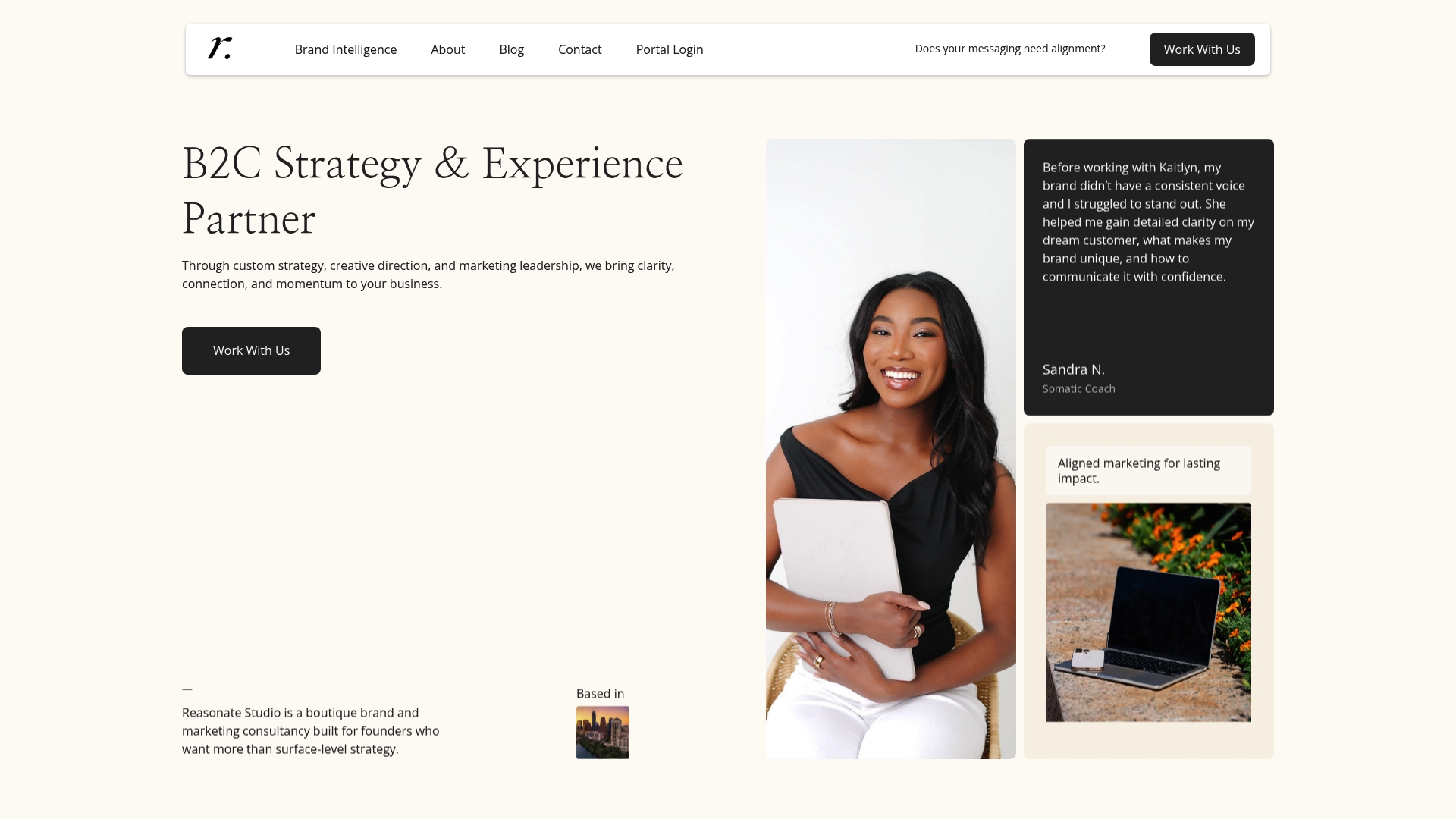Branding Strategies: Building Impactful Small Businesses

Learn how to create an influencer marketing strategy step-by-step. Clarify goals, identify partners, run campaigns, and optimize for real business growth.

Nearly 90 percent of marketers say influencer partnerships deliver results that surpass traditional ads. Tapping into influencer marketing can open doors to audiences your brand may never reach through regular campaigns. Building the right strategy means knowing exactly who you want to reach and how to connect with them in a way that feels both genuine and effective.
Before diving into influencer marketing, you need crystal clear goals and a deep understanding of who you want to reach. Think of this step as creating a strategic roadmap that connects your business objectives with the right audience and messaging.
Start by asking yourself what specific outcomes you want from your influencer marketing campaign. Are you looking to increase brand awareness, drive website traffic, generate leads, or boost product sales? Each goal requires a slightly different approach. For example, building brand awareness might mean partnering with influencers who have massive reach, while generating sales could mean working with micro influencers who have highly engaged niche audiences.
To pinpoint your target audience, go beyond basic demographics. Dig into their behaviors, interests, online habits, and pain points. What platforms do they spend time on? What content resonates with them? What challenges are they trying to solve? Your ideal target audience isn’t just an age range or job title - it’s a living, breathing group of people with specific motivations.
Pro Tip: Create a detailed audience persona that includes not just statistical data, but their aspirations, frustrations, and communication preferences.
Research is key. Use tools like social media analytics, customer surveys, and market research to build a comprehensive picture. Look at your existing customer base and identify common characteristics. What makes them unique? What drew them to your brand?
Remember that a well defined target audience allows you to craft more authentic, compelling influencer partnerships. The more precisely you understand who you want to reach, the more effectively you can design a campaign that genuinely connects.
Up next, you’ll learn how to find the right influencers who can authentically represent your brand and speak directly to your carefully defined audience.
Now that you know your target audience and campaign objectives, it is time to find influencers who can authentically represent your brand and connect with your ideal customers. Think of this process like matchmaking for your marketing strategy.
Start by using platform specific search tools and hashtag research to discover influencers in your niche. Look for content creators who already speak to audiences similar to your target market. Instagram, YouTube, TikTok, and LinkedIn each have unique search functionalities that can help you find potential partners.
When evaluating potential influencers, go beyond follower count. Modern research suggests using sophisticated computational methods to analyze an influencer’s true effectiveness. Look for indicators like engagement rates, audience quality, content consistency, and alignment with your brand values. An influencer with 10,000 highly engaged followers might be far more valuable than someone with 100,000 passive followers.
Pro Tip: Advanced research models like InfluencerRank analyze an influencer’s posting behavior and social relationships to predict their potential marketing impact.
Carefully review their content history. Does their communication style match your brand? Have they worked with similar companies? Check for authenticity signals like genuine audience interactions, consistent messaging, and a track record of transparent sponsorships.
Dont just rely on surface metrics. Watch their content, read audience comments, and assess how their personal brand might complement your marketing goals. An influencer who truly understands and believes in your product will create more compelling content.

Here’s a summary of influencer selection criteria:
| Criteria | Why It Matters | What to Look For |
|---|---|---|
| Audience Alignment | Reaches your target | Similar demographics Relevant interests |
| Engagement Rate | Measures influence | Consistent likes Genuine comments |
| Content Quality | Reflects brand values | High production Authenticity |
| Brand Fit | Ensures credibility | Shared values Similar tone |
| Past Partnerships | Shows experience | Quality collaborations Transparency |
In the next step, youll learn how to craft a compelling outreach strategy that turns potential influencer partnerships into meaningful collaborations.
With your ideal influencers identified, its time to design campaign offers that feel genuine and create real connections with your audience. Authenticity is the secret sauce that transforms a standard marketing campaign into a memorable experience.
Start by developing a collaborative approach. Instead of dictating every detail, invite influencers to co-create content that naturally integrates your brand. Recent research highlights that hard-to-reach audiences respond best to offers that feel culturally relevant and personally crafted.
Consider the unique strengths of each influencer. What storytelling style resonates with their audience? How can your product or service solve a problem or create an exciting experience for their followers? The most powerful campaigns feel less like advertisements and more like genuine recommendations from a trusted friend.
Pro Tip: Give influencers creative freedom within a clear strategic framework. Provide guidelines but allow room for their authentic voice and creativity.
Design offers that provide real value to the influencers audience. This might mean exclusive discounts, early access to products, or solving a specific problem their followers care about. Your campaign should feel like a natural extension of the influencers existing content not an awkward interruption.
Pay attention to the details of compensation and expectations. Be transparent about deliverables but flexible enough to allow the influencer to showcase your brand in a way that feels true to their personal brand. The goal is a partnership that feels mutually beneficial and authentic.
Up next, youll learn how to develop a comprehensive tracking and measurement strategy to ensure your influencer marketing efforts deliver meaningful results.
With your authentic campaign offers crafted, its time to launch your influencer partnerships and keep a close eye on their performance. Think of this stage as mission control for your marketing strategy where you track, analyze, and optimize in real time.
Start by establishing clear communication channels with each influencer. Schedule regular check ins to discuss content progress, answer questions, and provide supportive guidance. Make sure they feel supported but not micromanaged. Your goal is to create a collaborative environment where creativity can flourish.
Utilize specialized influencer tracking tools that provide comprehensive insights. Platforms like Traackr and CreatorIQ allow you to monitor engagement metrics, audience demographics, and content performance across multiple collaborators. These tools enable side by side comparisons that help you understand which partnerships are delivering the strongest results.
Pro Tip: Set up real time tracking dashboards that give you instant visibility into key performance indicators like reach, engagement rates, and audience sentiment.
Pay attention to more than just numbers. Look for qualitative signals of success like audience comments, content quality, and alignment with your brand values. An influencer generating fewer views but more meaningful interactions might be more valuable than one with massive but passive reach.
Be prepared to make agile adjustments. If certain content strategies are underperforming, work collaboratively with influencers to refine the approach. Flexibility and open communication are key to turning initial campaigns into long term successful partnerships.
In the next step, youll learn how to analyze your results and optimize future influencer marketing efforts for even greater impact.
As your influencer marketing campaign rolls out, its time to dive deep into measuring real results beyond surface level metrics. Think of this stage as your strategic review board where you transform raw data into actionable insights.
Start by looking beyond simple vanity metrics like likes and followers. True campaign success requires a holistic view of the customer journey. Track comprehensive indicators such as engagement rates, website traffic, conversion rates, and audience sentiment. Modern research emphasizes measuring the entire lifecycle impact of influencer partnerships.
Develop a multi touch attribution model that captures the nuanced ways influencer content drives customer behavior. This means understanding how different touchpoints contribute to eventual conversions. An influencer might not directly generate an immediate sale but could be critical in building brand awareness and trust that leads to future purchases.
Pro Tip: Use specialized analytics tools that can track customer interactions across multiple platforms and touchpoints to get a more comprehensive view of your campaigns effectiveness.
Combine quantitative data with qualitative insights. Read audience comments, analyze content performance, and gather feedback from both influencers and their followers. The most valuable insights often come from understanding the emotional and psychological impact of your campaign.
Be prepared to iterate quickly. If certain strategies are not delivering expected results, dont be afraid to make strategic adjustments. The most successful influencer marketing approaches are those that remain flexible and responsive to real world performance data.
Your next step is to use these insights to build even more powerful influencer marketing strategies that continuously improve and deliver exceptional results.

You have just read about the steps to create an influencer marketing strategy that actually converts. Whether you struggle with defining clear objectives, finding influencers who truly align with your brand, or creating campaigns that feel authentic and measurable, you are not alone. Many entrepreneurs feel overwhelmed by the details and the pressure to show real results—but effective influencer marketing should drive both clarity and impact, not just vanity metrics.

If you want a proven framework that ties every phase of your influencer strategy to business growth, let Reasonate Studio be your guide. Using our proprietary Aligned Impact Model™, we help small business owners and founders build strategic systems that connect audience insights, genuine storytelling, and measurable outcomes. Do not let another campaign drift without direction. Visit Reasonate Studio now to book a free discovery call and see how you can build an influencer marketing strategy that is simple, authentic, and designed for real results.
To create an effective influencer marketing strategy, start by identifying specific goals such as increasing brand awareness, driving website traffic, or generating leads. Clearly outlining these objectives will help refine your overall approach and messaging to better target your audience.
Find influencers by researching your niche on platforms like Instagram or TikTok using specific hashtags and audience analytics. Evaluate potential influencers by looking at their engagement rates, content quality, and how well their values align with your brand.
Design campaign offers that provide genuine value to the influencer’s audience, such as exclusive discounts or early access to products. Ensure to allow influencers creative freedom so that the content feels genuine and resonates naturally with their followers.
Measure success by analyzing key metrics like engagement rates, website traffic, and conversion rates rather than just likes and followers. Implement a multi-touch attribution model to understand how different influencer interactions impact customer behavior over time.
Regularly check in with influencers throughout the campaign to discuss content progress and provide support without micromanaging. Aim for at least bi-weekly communication to ensure both parties are aligned and any issues can be quickly resolved.
After your campaign, review both quantitative metrics and qualitative feedback to identify what worked and what didn’t. Make adjustments based on performance data, and plan to iterate on your strategy to continuously improve future campaigns.